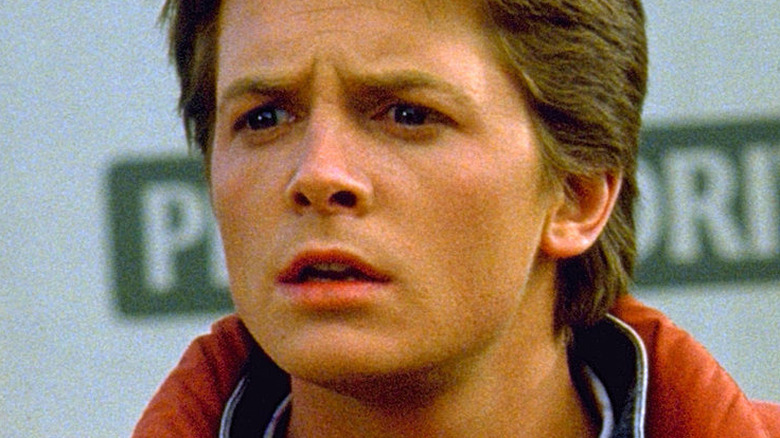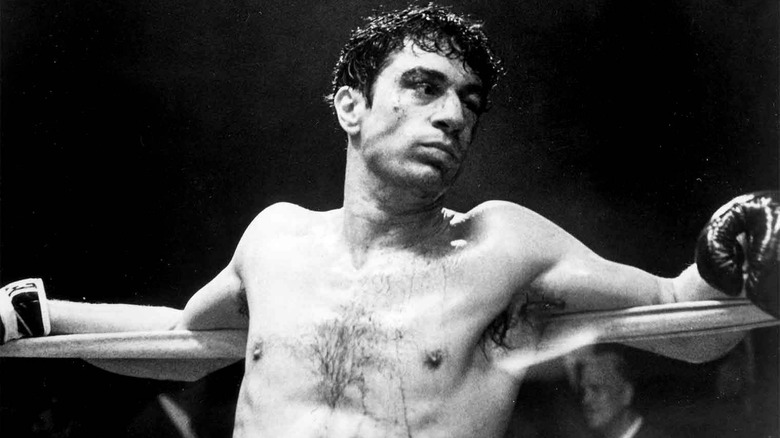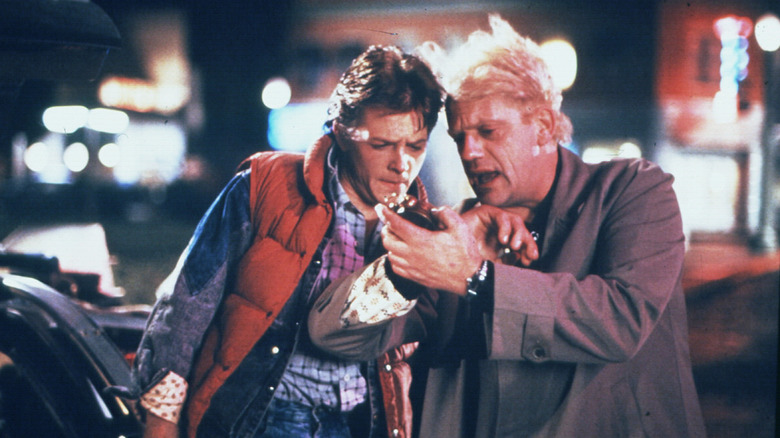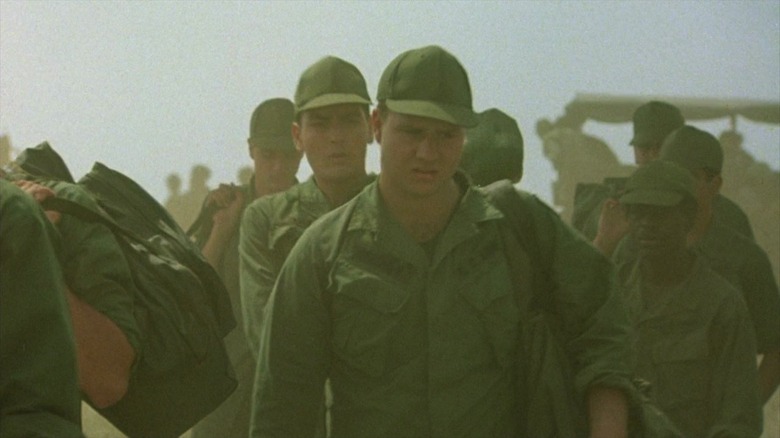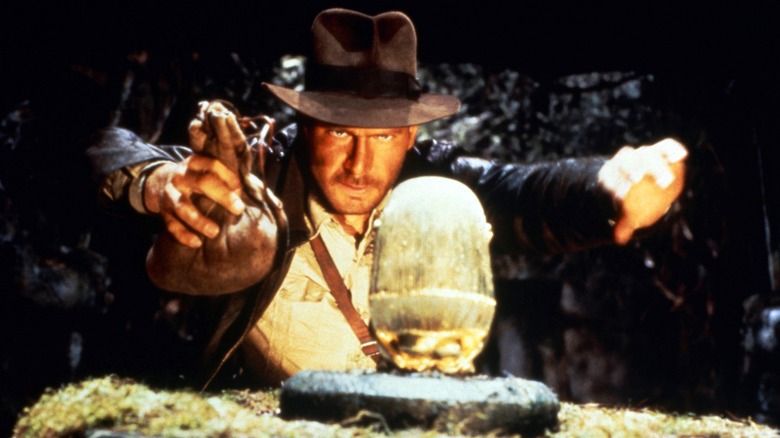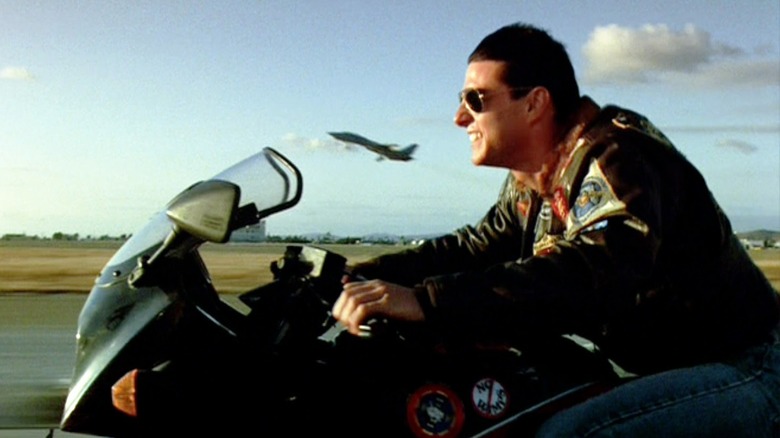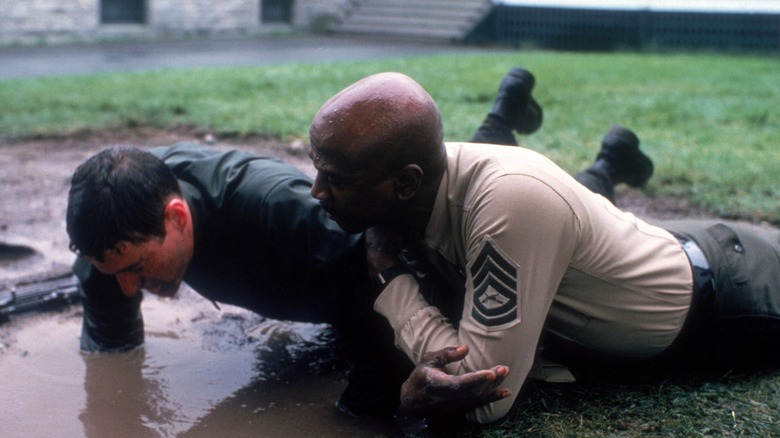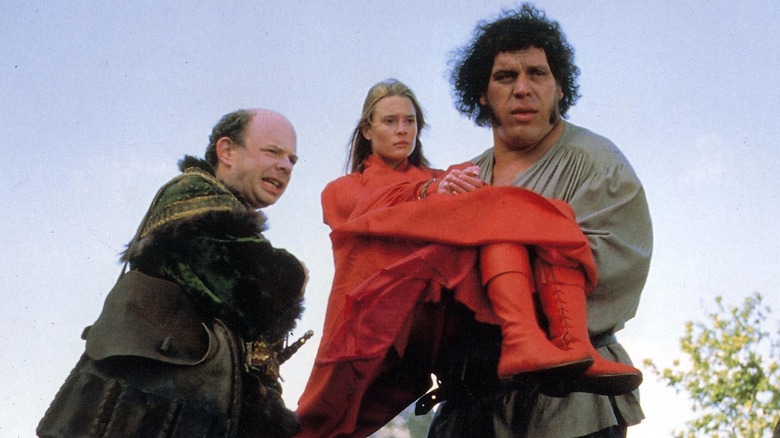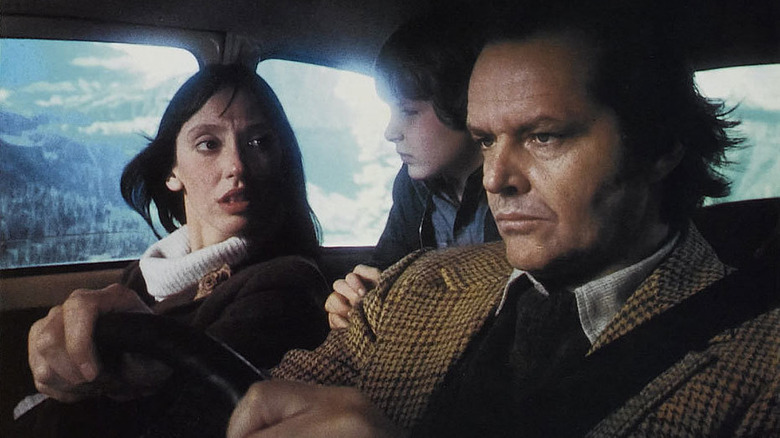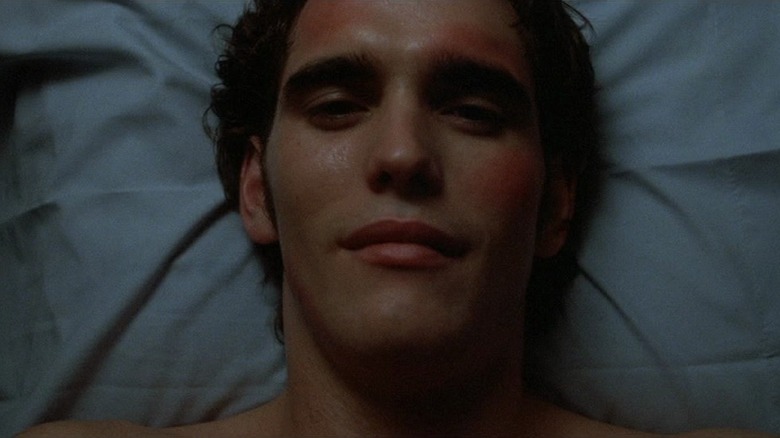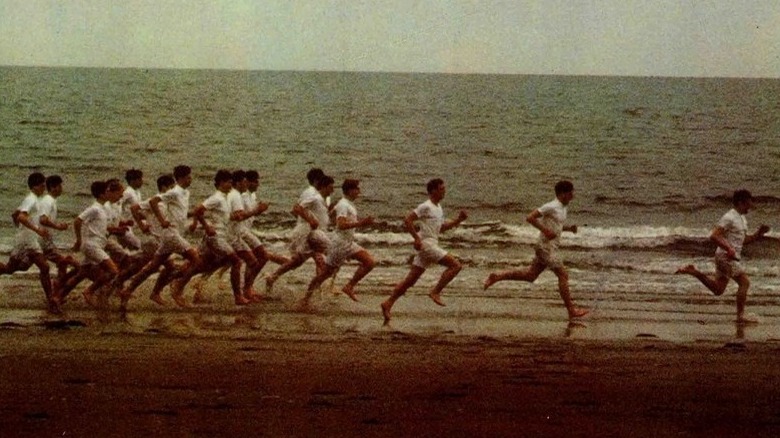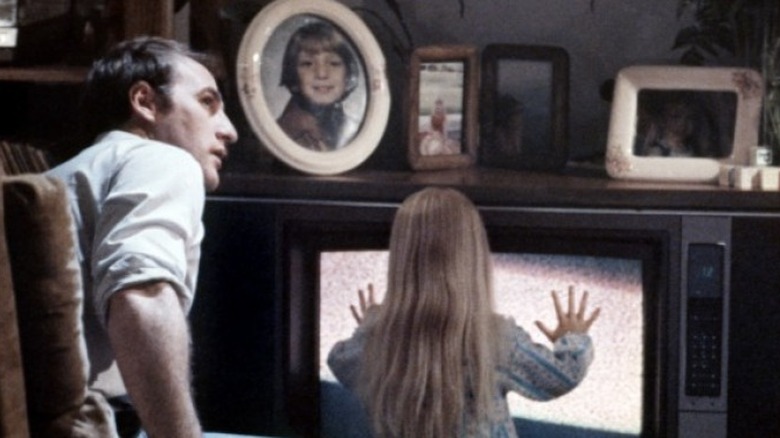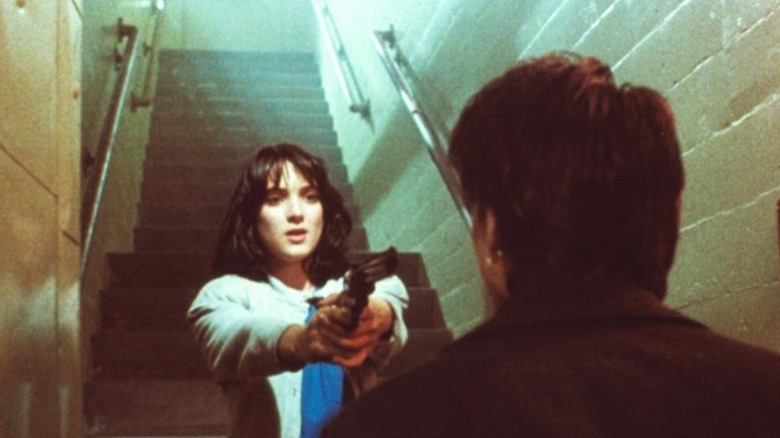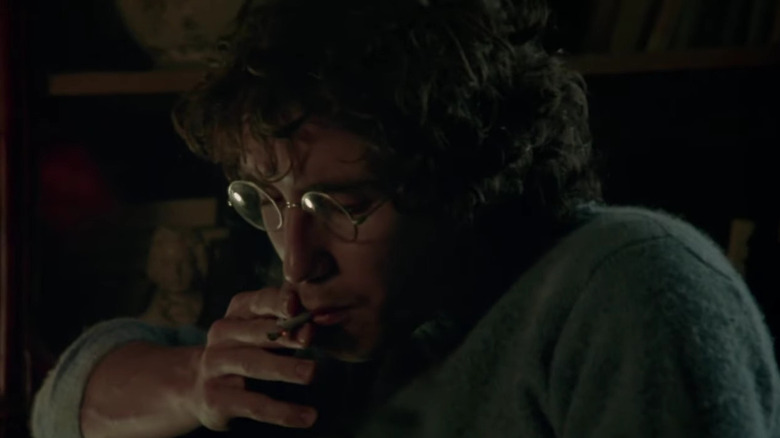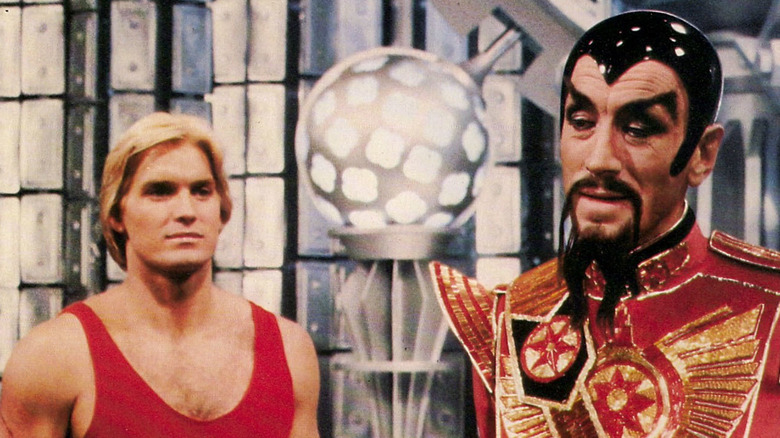The Best Opening Scenes In 80s Movies
Opening scenes are a tricky proposition. In reality, there are no real beginnings or endings. Yet everything has to start somewhere and when it comes to celluloid, the director has the unique opportunity to play god and use their vision to reshape the world. The opening of any film is the director's best chance to grab the audience's attention. Opening scenes are an all-or-nothing kind of gamble. Get it wrong and you'll lose the audience quicker than you can say, "It's a wrap!" Get it right and they'll be eating out of your hand and champing at the bit to see how the action unfolds.
First impressions matter, and opening scenes are often an audience's abiding memory of a cinematic experience. Think "Apocalypse Now," "Goodfellas," and "Inglourious Basterds" for opening scenes that have the Midas touch. Not every great movie has a great opening scene, but those that do shine from the first frame like the birth of a supernova. Here are some classic opening scenes from '80s movies that time hasn't forgotten.
Raging Bull
Although technically it might not be an opening scene as much as it is an opening shot, the first couple of minutes of Martin Scorsese's 1980 epic "Raging Bull" perfectly encapsulate the character of Jake LaMotta and the film's themes of male violence, self-destruction, and the all-consuming hunger for meaning. Watching a hooded Robert De Niro pace the ring and throw punches lets the audience know this is a film about a boxer. Yet the scene's existential atmosphere reveals it's also a film about an individual's eternal struggle against himself, other people, and an indifferent universe. The opening scene of "Raging Bull" is where art and boxing clash to create something spellbinding.
Shot in black and white and slow motion, the scene possesses a sense of unreality. This is heightened further by context. LaMotta is alone in a ring that could be anywhere, and in any period in history. The smoke-filled atmosphere, the occasional flash of a lightbulb, and the few discernible spectators conspire to make the viewer feel as if LaMotta is gearing up to fight the world itself. DeNiro moves with the assurance and grace of a man in his natural environment and the scene perfectly captures the image of a natural-born fighter. As the lonely and soaring violin of Pietro Mascagni's "Intermezzo" from '"Cavalleria rusticana" plays, the audience is completely engaged in the world of a boxer whose only true opponent is himself, and one he is destined to fight alone, and forever.
Back to the Future
As fitting for a film about time travel, there are a lot of clocks in the opening scene of Robert Zemeckis' "Back to the Future." They make that sort of lulling tick-tock that hypnotizes the audience into a receptive state which is only interrupted by a newsflash about stolen plutonium. The camera pan of the automated toaster, coffee maker, tin opener, and a dog bowl with the name Einstein emblazoned upon it all intrigue the audience with the question, "Who lives in a house like this?" When Marty McFly (Michael J Fox) first appears, and his skateboard accidentally rolls into a case of plutonium, plotlines are masterfully created. Who is this kid and why is he here?
When Doc rings up and starts talking excitedly about a "major breakthrough" and demanding Marty meet him that night, we're already curious enough to carry on watching. Yet it's the moment when Marty realizes he's late for school, jumps on his skateboard, and grabs onto the back of a truck to pick up speed that makes this scene a classic. What kid in the 1980s didn't have dreams of effortlessly skating to school in such a manner? Cruising along to "The Power of Love" by Huey Lewis and the News, the hapless and big-hearted Marty McFly immediately captivated an admiring audience.
Platoon
"Adagio for Strings" by Samuel Barber is a haunting piece of music under any circumstances. Yet when the sorrowful masterpiece was used for the opening scene of Oliver Stone's "Platoon," it added a certain gravitas and immediately helped the film form an empathetic bond with the audience. As the music plays and the smoke clears, we're confronted with a busy landing strip in the heart of Vietnam. All is chaos as fresh-faced volunteer Chris Taylor (Charlie Sheen) gets off the plane. The raw recruits look a little lost and overwhelmed as Stone manages to capture the surreal nature of what it must be like to land in a foreign country with orders to kill as many fellow human beings as possible.
As Taylor rubs his eyes with tired excitement, someone taps on his shoulder and draws his attention to the convoy of body bags before an impatient voice snarls, "Alright you cheese sticks, welcome to the Nam." A group of battle-hardened soldiers passes Taylor and one haunted vet gazes into Taylor's curious eyes with a thousand-yard stare. The scene is understated and subtle. Nevertheless, it invokes in the viewer a wordless understanding of the neverending futility of war and forces them to care about what happens to Taylor and his buddies next.
Raiders of the Lost Ark
The opening scene of Steven Spielberg's "Raiders of the Lost Ark" is like a ten-minute movie in itself. And not just any movie, but an action-packed blockbuster with enough twists, turns, and tension to leave you screaming for, "More! More! More!" In a sense, the rest of the film is almost a sequel. The opening scene is a self-contained and exquisitely structured story that grabs the audience by the collar and drags them on an adrenalized rollercoaster ride. It's got mystery, betrayal, adversity, near-death, triumph, and humor, and by the time it's over you feel you need a break to take stock and gather your senses before tucking into the main meal.
Yet Spielberg's real mastery is the way he maintains pace whilst simultaneously inviting the audience under the skin and into the world of Indiana Jones (Harrison Ford). By the end of the opening scene, the audience knows Jones is tenacious, tough, adventurous, determined, accident-prone, charismatic, and funny. Most of all, they know they really like this guy and want to spend more time in his company.
Top Gun
The sound of church bells mixed in with the 1980's drum machines and synthesizers during the opening scene of Tony Scott's "Top Gun" has an ominous quality. Yet as the music builds all residual foreboding is dispelled as we see the silhouettes of men on a landing aircraft at dawn, making complicated hand signals and carrying out strange rituals. The message is, these are people who live in a different world, where the roar of fighter jets and cocky pilots rule. Don't you want a ringside seat? When the jet engines ignite,and take off as Kenny Loggins' "Danger Zone" kicks in, the answer to that question is a resounding yes!
The mastery of man over machine, the seduction of speed, and the sight of cool-looking planes taking off and landing all conspire to create a dynamic first impression. It's like watching the genesis of something spectacular and an invitation into a world that is usually heavily guarded and out of bounds. Yet the real beauty of the opening scene of "Top Gun" is that even though we see the ground crew carrying out their tasks, the pilots, for now, remain hidden and elusive in their cockpits. "Top Gun" revolves around these elite sky warriors and their implied presence but tangible absence from the opening scene is a classic tease that draws the audience in.
An Officer and a Gentleman
It's usually the final scene of Taylor Hackford's "An Officer and a Gentleman" that everyone talks about in reverential tones. Although the opening scene doesn't quite live up to the dizzying highs when Zack Mayo (Richard Gere) marches into the factory in a whiter-than-white uniform and whisks Paula Pokrifki (Debra Winger) far away from a life of menial drudgery, it runs a close second. Watching his dad asleep with a prostitute, Mayo has flashbacks. Immediately, an engaging narrative unfolds. We know Mayo has had a tough upbringing, is a troubled soul, and looking for some light at the end of the tunnel.
As he watches his dad awake from a hard night, puke, and then crack open a beer, Mayo's desire to build a better life for himself is tangible. When he tells his dad he wants to fly jets and be an officer in the Navy, his father reacts with disdain. The scene is all about casting Mayo as the eternal underdog in the audience's mind and generating sympathy for a character who is about to embark on a journey that will test him to his limits. It's masterfully done because before the scene ends, we know Mayo's life story and are committed to being in his corner for the film's duration.
The Princess Bride
Rob Reiner's "The Princess Bride" is a strange and enchanting gem of a movie that casts a spell on the audience from the opening scene. It begins with a poorly child (Fred Savage) in bed playing video games. His immersion in some classic 1980s console action is broken by the visit of their grandpa (Peter Falk) who beings them the unwanted present of a book. The book is an heirloom that has been read aloud to countless generations of the family. The boy isn't too keen to have the book read to him but the grandpa promises a tale of, "miracles, true love, giants, torture, revenge, chases, escapes. The boy promises, perhaps symbolically on behalf of the audience, to "Try and stay awake," and we're off!
The opening scene of "The Princess Bride" works so well because it plants the seed in the audience's mind that watching a film, particularly this film, is no different from the transcendental magic of having a book read to you as a child. From the opening line, "Buttercup was raised on a small farm...," our imaginations are busy making crucial associations with warm memories of fairytales past. It's an unusual hook to open a film with but a hugely-effective one. Once awakened, the desire to see what comes next is an all-powerful one.
The Shining
From the very first sweeping helicopter shots of the Montana wilderness in the opening scenes of Stanley Kubrick's "The Shining," the audience is given the impression that they're been taken far from the everyday, the mundane, the safe, and into a world where all bets are off. The simplistic dirge that accompanies the scene jangles the audience's nerves and creates a strong sense of foreboding. As the camera slowly tracks Jack Torrance (Jack Nicholson) and his family in their yellow Volkswagen Beetle through the Glacier National Park, Kubrick creates a sense of unease and dread that contrasts sharply with the breathtaking beauty and sun-dazzled glory of the surrounding landscape.
Except for a couple of seemingly abandoned cars, and motorists going in the other direction from wherever Torrance is headed, there is no other sign of human life. The scene conjures up connotations of an individual alone and helpless in the face of overwhelming and pitless natural forces. Even though Torrence is behind the wheel and seemingly the architect of his own destiny, he is being pulled by hidden strings towards some terrible destiny. That destiny of course is The Overlook Hotel. The scene ends with the audience getting their first glimpse of that notorious house of horrors in the snow capped mountains, and to say it has presence is an understatement. By shooting the opening scene of "The Shining" from a helicopter high in the sky, Kubrick almost suggests that coming events have a universal significance that will trouble and touch even the most remote spectator.
Drugstore Cowboy
Much like Brian De Palma's "Carlito's Way," Gus Van Sant's "Drugstore Cowboy" begins with the chief protagonist in a bad shape. Matt Dillon's character Bob is seemingly lying in bed in a kind of drug-induced or religious serenity before he confesses, "I was once a shameless full-time dope fiend." As opening lines go it may not be, "Call me Ishmael," but it certainly makes the audience sit up and chew their popcorn a little more slowly. Before you know it we're having cine film flashbacks and Bob is telling us about his life as head of a crew who robbed drugstores. We're introduced to the key players in a tale that he infers ends in tragedy. After Bob laments, "Deep down I knew we could never win," the shot pulls back to reveal the interior of an ambulance.
When you kick-off a film with an opening scene that pretty much suggests it all ends in flames, you've only got a brief window to make that character charismatic enough and events interesting enough for the audience to sit through the next couple of hours, and Van Sant pulls it off in style. Dillion brings his A-game to the table and draws the audience in from the get-go with his world-weary confessional. He gives the impression that it's just you and him in some after-hours smoke-filled club. As the slow jazz plays, the whiskies are drunk and he regales you with yet another colorful story, who in their right mind would ever want to leave before the last waltz?
Chariots of Fire
Director Hugh Hudson's "Chariots of Fire" is a film about triumph over adversity, outsiders finding their palace, and the strength and resilience of the human spirit in the face of immeasurable odds. Oddly, it begins with the funeral of one of its key characters, Harry Abrahams (Ben Cross). Yet as the elderly Lord Andrew Lindsay (Nigel Havers) gives a stirring speech in memory of his old friend and said, "Now there are just two of us, young Aubrey Montague and myself who can close our eyes and remember those few young men with hope in our hearts and wings on our heels," it cuts back in time to a group of athletes running through the surf on a beach, and one of the greatest opening scenes of the 1980s is born.
The runners display a camaraderie, a youthful exuberance, and a sheer unbounded joy that is a million miles removed from old age, frailty, and death. Running has always worked as a powerful metaphor for the plight of an individual trying to outdistance the ravages of time. Throw Oscar-winning composer Vangelis Papathanassiou's well-known score into the equation and the scene is enough to give the most cynical soul goosebumps. If you were a kid growing up in the 1980s at some point you and your friends would have run in slow motion whilst humming the "Chariots of Fire" theme tune. Such is the power of film.
Poltergeist
Director Tobe Hooper's "Poltergeist" is a genuinely scary film. Not least because it reminds us there was a time before streaming and, worse than that, when a lot of TV stations used to switch off in the early hours. As the last strains of the American national anthem are played out in the Freeling household and the TV image of US Marines raising a flag atop Iwo Jima's Mount Suribachi flickers and fades to static and white noise, the audience has an instinctive understanding that something wicked this way comes. The dog wakes up, as does little Carol Anne Freeling (Heather O' Rourke). She's compulsively drawn to the TV in the twilight hours, not to binge on a new season of "Stranger Things" but to talk to dead people.
It's a chilling premise that was ice cold back in 1982 when Steven Spielberg's story hit our screens. The opening scene featuring a young child conversing with ghosts in the TV as the static flickers upon her completely absorbed features is iconic and sets the tone for a unique and unsettling premise. The opening scene of "Poltergeist" was warning the world of the dangers of too much screentime before that was even a thing.
Heathers
The opening scene of Michael Lehmann's "Heathers" has elements of a period costume drama. "Que Sera, Sera (Whatever Will Be)" plays softly as three young high-society ladies flounce gaily through the immaculately groomed lawns of some country garden carrying croquet sticks. Yet the spell of tranquil and well-mannered gentility is broken when all three purposefully trample through the flowers as opposed to walking around them. The illusion is shattered further when the audience realizes that all three ladies share the name, Heather.
The final jigsaw piece that these young ladies are in fact, borderline sociopaths falls into place when we see they are aiming croquet balls in the direction of Veronica Sawyer (Winona Ryder) who is buried up to their neck in the lush greens. Yet we soon learn that Veronica is not a victim but a willing participant in a film that's themes are social status, privilege, and the abuse of it. "Heathers" opening scene is not just memorable for its shock value but because it lets the audience know in no uncertain terms that this is a subversive film where things are turned on their head just for the hell of it.
Withnail and I
It's hard to capture the soul-destroying, fear-inducing, creeping paranoia, and paralyzing ennui of a severe hangover on film, but in the opening scene of "Withnail and I," director Bruce Robinson comes close. As Paul McGann's character stares with deep regret into space and desperately puffs on his cigarette as if his life depended upon it, the audience is painted a picture of a man down on his luck, living in a wreck of a flat, and in the unyielding grip of a three-day bender. As he makes a half-hearted attempt to shake off the blues, fight back the nausea and keep the wolf of existential despair from his door, our hero gets up to make a cup of tea. The task is too Herculean for him and he decides to venture outside instead.
Before he departs, he knocks on an interior door and impatiently asks, "Do you want a cup of tea Withnail?" He's met with Richard E. Grant's voice booming a resounding "no!' That simple scene sets up Withnail and the nameless character known solely as "I," as partners in crime and comrades in addiction. Their strange dance together will define the film. The opening scene of "Withnail and I" is also notable for King Curtis playing an epic live version of Procul Harum's "Whiter Shade of Pale." Whether intentional or not, The crowd's spontaneous applause almost sounds as if they're mocking the misery of McGann's character and sets the stage perfectly for this darkest of comedies.
Flash Gordon
The opening scene of Mike Hodges' "Flash Gordon" starts innocuously enough with a shot of outer space. Yet soon things get interesting when a disembodied voice of pure pantomime evil croons, "Klytus, I'm bored. What plaything can you offer me today?" It's the voice of a bored and petulant child and belongs to Ming the Merciless (Max von Sydow) who has just been offered planet Earth to toy with. With the help of some seriously bad graphics, Ming's spaceship targets earth as the intergalactic dictator sighs, "How peaceful it looks," before pointing a weird ring of power at it. The word "earthquake" flashes up on the dodgy-looking computer screen and Ming and his sidekick start giggling maniacally.
When Ming's mate asks the merciless one if he'll destroy the earth, his master simply snaps, "Later! I like to play with things a while before annihilation." Cue more maniacal laughter. Obviously, the audience is on board immediately that this is a guy who needs to be stopped, and fast! As the intro of "Flash" by Queen kick in and Freddie Mercury starts singing about a man who is a "miracle," a "king of the impossible," and who will, "save every one of us," we have our hero. It's not subtle but who cares? Alex Raymond's original "Flash Gordon" art which accompanies the opening was truly groundbreaking for 1980. The opening scene of the movie may or may not have influenced Marvel. Either way, it's in a league of its own.
